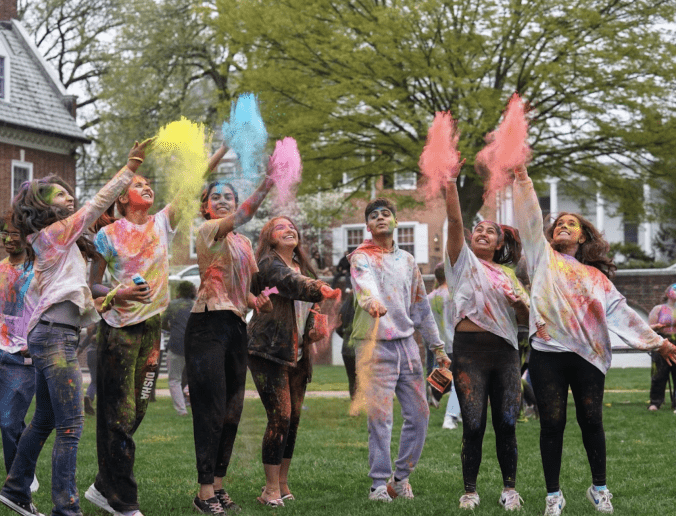As mentioned in my previous posts, I am a third year Honors student serving as the President of UD’s Indian Student Association. Each year, one of our biggest events of the spring semester is the celebration of Holi. You may know Holi as the festival of colors, but here is your chance to learn more about the specifics and origins of the holiday!
What is Holi?
Holi is a festival observed by millions of Hindus around the world, marking the arrival of spring and celebrating the triumph of good over evil.
Based on popular Hindu mythology, this festival’s origin begins with a king named Hiranyakashipu, a demon filled with arrogance and greed. He thought himself to be above god and expected that people treated him as such. Hiranyakashipu had a personal vendetta against Lord Vishnu, Preserver and Protector of the Universe, for slaying his twin brother Hiranyaksha. Upon finding out that his own son was an unwaveringly faithful devotee of Lord Vishnu, the evil king made many attempts to have the boy killed. After several failed efforts, he enlisted his sister Holika, whose boon included being protected from fire, to trick his son into a fire pit with her, where he would inevitably burn and she would not. Although the bonfire was lit, the boy’s continued devotion to Lord Vishnu led to him being protected by the god himself. Meanwhile, Holika did not survive despite her immunity, and thus came the name of the festival as well as the tradition of lighting large pyres to signify the burning of evil spirits on this day. The story of Holika serves as a firm testament that good always prevails over evil, a recurring theme in Indian culture.
When is Holi celebrated?
Each year, Holi is celebrated on the last full moon day of Phalguna, the last month of the Hindu lunar calendar, which usually takes place around February or March. Holi is actually a two-day festival, so this year, Holi began on March 7th and ended on March 8th.
How is Holi celebrated?
On the first night, Holi is celebrated as Holika Dahan, where prayers are performed around a large bonfire which is then lit as a representation of burning away negative spirits, thoughts, and energies, and starting off the new season positively. Many different types of things are thrown into the flames, such as wood, leaves, grains, coconut, and chickpeas. The second day is known as Rangwali Holi (colorful Holi) which is when people celebrate in their communities with a variety of colored powders, water, music, and dancing, followed by delicious feasts shared among friends and relatives.
How do we celebrate Holi at UD?
At UD, the Indian Student Association pairs up with the Indian Graduate Student Association (IGSA) so that we can collaborate to make our celebration as grand and enjoyable as possible for our collective members. Our Holi event is generally held in early April so that we can take advantage of the warmer weather, and we provide an assortment of colored powders, water toys with a kiddie pool, and play all kinds of different music to cater to our wide ranging audience. And the best part about this event is that it’s free, so anyone can join in on the fun! Our main purpose is to make sure that our members have the opportunity to come together and celebrate their Indian culture and heritage despite being away from home, while others can also join in and integrate themselves into the community. If you were passing by the North Green last Friday, surely you heard and saw the festivities for yourself, but even if you missed it, here are some snapshots of our 2023 Holi celebration!
All images are courtesy of Kirk Smith at The Egg!








April 14, 2023 at 10:31 am
Thank you for sharing this piece of your cultural heritage with us!